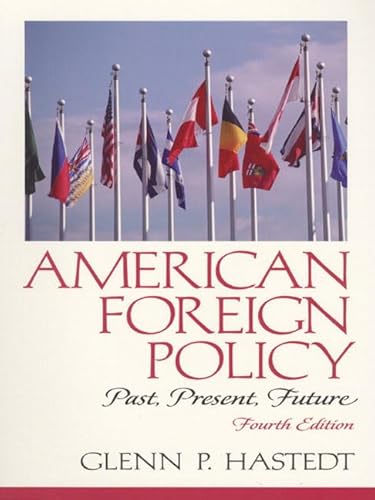American Foreign Policy: Past, Present, Future (4th Edition) - Softcover

< This book integrates case studies and conceptual material to give readers a historical perspective of U.S. foreign policy. It develops an understanding of both the hows of the foreign policy making process as well as the whys, challenging readers to consider the ways in which foreign policy will need to change in the future. KEY FEATURES: Includes a discussion and new case study on Bosnia in the chapter on presidential decision making. Introduces a new chapter on the evolving post cold war policy agenda. Makes extensive use of case studies. For political scientists.
"synopsis" may belong to another edition of this title.
For more than one decade American foreign policy seemed to be adrift. The cold war had ended, but the post-cold war era had yet to take on a defining characteristic. For many, the post-cold war era offered the prospect of realizing goals and objectives long held to be unattainable because of the demands of national security considerations. It was a moment to be seized and acted upon. For others, little had changed in the game of world politics. Bold initiatives to build a new world order were to be shunned in favor of policies designed to preserve American hegemony or maintain a favorable balance of power. Finally, for some the post-cold war era appeared to offer an opportunity to adopt an isolationist foreign policy that would protect America from the corrupting consequences that followed from involving itself in the affairs of others.
The scope, intensity, and pace of the debate on the future direction of American foreign policy in the post-cold war era changed with dramatic suddenness on September 11, 2001, with the terrorist attack on the World Trade Center and the Pentagon. For at least a moment, the shape of the post-cold war era became clear to most Americans and the need for debate about the content and conduct of American foreign policy was no longer self-evident. Yet, before the month had ended newspaper accounts began to record expressions of doubt and caution about the feasibility of the original set of foreign policy goals set forward by President George W. Bush, the language being used to frame the issue, and the proper American response.
The terrorist attack on the World Trade Center and the Pentagon thus did not mark the end of debate over American foreign policy. Instead, it marked a new reference point for the debate as it moves forward. We continue to need to understand where we have been, where we are today, and where we want to go. Choices continue to exist. We can continue to find reasons for optimism and pessimism as we look to the future.
Conceptually and organizationally, the fifth edition of American Foreign Policy: Past, Present, Future remains the same. Part I examines the global context of American foreign policy. Two chapters look at the global setting and the emerging foreign policy agenda. Part II examines the historical context of American foreign policy. Chapters in this section deal with post-Vietnam foreign policy and learning from the past. Part III examines the foreign affairs government. It includes chapters on the domestic context of American foreign policy, the Constitution and foreign affairs, and the political institutions that play leading roles in the making of American foreign policy. Part IV looks at the process by which foreign policy is made. One chapter examines models of policy making and the other presents a series of case studies. Part V presents an overview of the policy tools at the disposal of policy makers. A focus on policy tools rather than problems is used because this type of discussion can be readily directed at whatever current foreign policy problems sit atop the agenda. Part VI concludes the discussion of American foreign policy with a survey of alternative futures. Each future is discussed in terms of (1) the major threat to American security interests, (2) the responsibility of the United States to other countries, and (3) the responsibility of the United States to the global community.
Material in each chapter has been updated to include recent events in American foreign policy. Sections on terrorism have been included in Chapter 2's discussion of the emerging foreign policy agenda, Chapter 16's discussion of military power, and Chapter 18's discussion of alternative futures. The discussion of several of the alternative futures has been updated to make them more relevant to the current situation. In addition, several chapters have been reorganized to incorporate new information. The discussion in Chapter 17 on economic policy has been recast to better capture the distinction between the American general strategic orientation to international economic policy and specific tactics. Chapter 6 on domestic influences now contains discussions of political protest and religious interest groups. Chapter 8 on the presidency now contains a discussion on presidential foreign policy transitions. And Chapter 13 on diplomacy now includes a discussion on the United Nations.
I would like to thank the following reviewers: Shannon Blanton, University of Memphis; Chris Van Allen Winthrop University; Guoli Liu, College of Charleston; and Lui Hebron, Florida International University.
Glenn P. Hastedt
"About this title" may belong to another edition of this title.
- PublisherPrentice Hall College Div
- Publication date1999
- ISBN 10 013083579X
- ISBN 13 9780130835796
- BindingPaperback
- Edition number4
- Number of pages429
- Rating
Buy New
Learn more about this copy
Shipping:
US$ 8.13
From United Kingdom to U.S.A.
Top Search Results from the AbeBooks Marketplace
American Foreign Policy
Book Description Condition: New. pp. xvi + 429. Seller Inventory # 58152022

